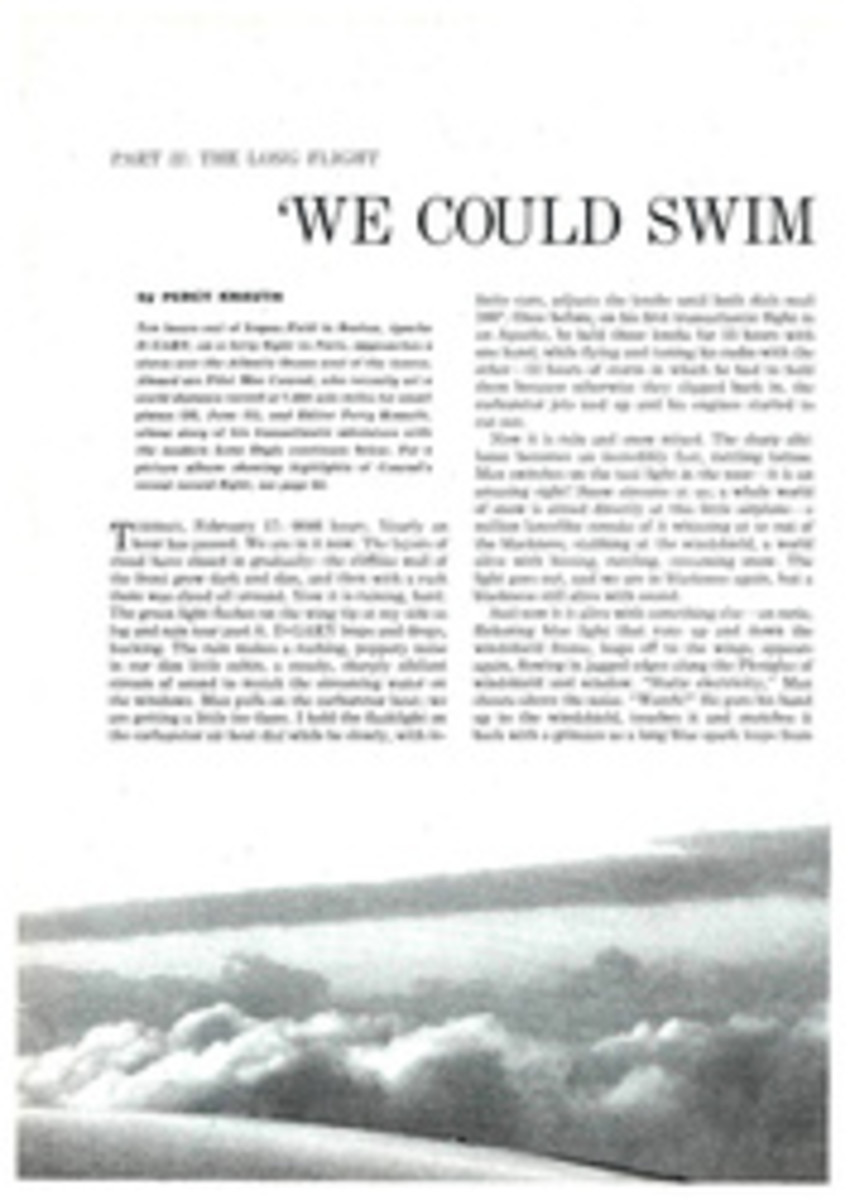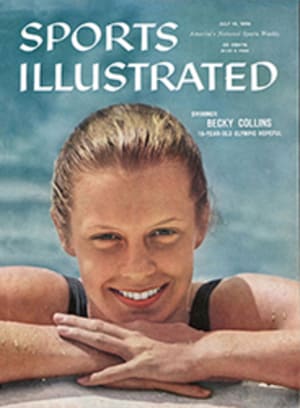
THE RUGGED RETRIEVERS
On the following pages Sports Illustrated continues the four-part series with step-by-step instructions on how to train the retrieving breeds. Shown above are the six most popular retrievers in this country. In recent years, however, several, like the standard poodle, have appeared more often in show rings than in duck blinds. All of these breeds, nevertheless, are built for rough work in the outdoors, and specifically for use in duck and goose shooting. Their dense waterproof coats, great physical stamina and superb swimming ability equip them to work under even the most adverse weather conditions and in the most difficult country. In fact, many retrievers actually seem to be at their best when weather conditions are at their worst. Like the flushing spaniels and trailing hounds discussed in Parts I and II, however, retrievers must be carefully trained before they can be expected to do a good job in the field. With practice and patience, all of the six dogs shown in the panel above can become excellent hunting companions, and, equally important, they can contribute a great deal to conservation by preventing the waste of crippled and lost birds.
JAMES A. COWIE
Son of a Scottish gamekeeper, James Cowie of Commack, N.Y. grew up handling gun dogs in Pitlochry, Scotland. Since coming to this country in 1920 he has schooled hundreds of retrievers, and three times in succession won the Labrador Retriever Club Championship.
First months afield
A retriever is born with an instinct to fetch, and he usually shows signs of it by playfully picking up any object thrown to him. This does not mean that he is ready to start his formal field training. You may actually discourage his natural instincts if you try to train him too early. Most dogs are not ready until they are about 9 months old. Some Labradors can be started sooner but Chesapeakes and goldens often do better when training begins at 11 or 12 months. Until this time take the pup out every day (or as often as possible) for runs of no more than 15 minutes and just introduce him to the outdoors. Walk with him through fields and brush so he gets used to varied terrain. Let him play with a glove by throwing it to him. When he picks it up, call him back to you by blowing several short, soft blasts on a training whistle (25¢). Praise him if he fetches it to you but don't correct him if he does not. Your goal now is simply to acquaint him with the outdoors and with one simple whistle command.
Blow whistle to call pup to you as he retrieves glove.
First formal exercises
When the pup is used to the outdoors and has learned the basic sit, stay, and come commands from his home training (SI, July 14 & 21, 1958), he is ready to start formal work in the field. Begin by making him sit. Take hold of his collar and throw a training dummy ($2.95) about 10 yards. Release him on the command, "Fetch," and direct him toward the dummy with a sweeping movement of your arm. As soon as he picks up the dummy, whistle him back to you. If he runs the other way, don't chase after him. Instead step back and call him by name. When he finally comes to you, be ready to take the dummy from him before he drops it. Spend several weeks on this exercise and ignore his mistakes.
Hold dog in sit position, then throw training dummy.
Step back and lake dummy from dog before he drops it.
First experience with gunfire
After the pup has learned to fetch the dummy and deliver it to your hand, he must become accustomed to gunfire. For exercise put the dog on a long lead and make him sit. Holding the end of the lead, step away from him. Then throw the dummy as far as you can and, while it is still in the air, fire a training pistol. If the dog breaks, jerk sharply on the lead, repeating the command, "Sit." When he is finally steady, drop the lead and command, "Fetch." Practice this exercise daily, correcting him if necessary, so he learns to remain motionless until you send him to retrieve.
With dog on lead, command "Sit," then throw dummy.
If dog breaks at sound of pistol, pull sharply on lead.
First blind retrieves
In hunting, particularly from a blind, game often falls out of the dog's line of sight. He must learn, therefore, to find birds he did not actually see. The dog already knows that a series of short whistle blasts means "Come." Now teach him that a single, short blast means "Stop" (Field Training: Part I, June 15). Once he has mastered this command, have a friend plant the dummy out of the dog's sight. Send the dog straight ahead, then stop him by whistle. His instinct will be to look at you. When he does, call out, "Fetch," and move your arm in the direction of the dummy. If he gets off course, stop him again and repeat the arm signal. As soon as the dog is following your directions, substitute a dead bird for the dummy so he becomes used to feathers and game scent. At this same stage of training, ask a friend to fire a shotgun from about 30 yards away each time you send the dog to retrieve. Have the friend move closer as the dog becomes accustomed to the noise of the gun. Spend about two months on this training.
Dog starts blind retrieve by moving out on word "Fetch."
Dog stops at whistle, looks back for your arm signal.
Dog sets out in new direction as trainer moves arm, body.
Working in the water
Most retrievers are ready to start working in the water after about three months of formal field training. If the weather is very cold, however, it is better to wait a few months longer. The dog will not mind freezing water once he is used to it, but you may frighten him if you start him off with an ice-cold plunge. The best place to begin this training is a shallow pond with a firm, sandy bottom. (Avoid salt water because the dog may try to drink it.) Take the dog to the edge of the pond and, with your hand on his collar, make him sit. Throw the dummy about 10 yards out. Wait until it hits the surface, then command, "Fetch." Most likely the dog will leap instinctively into the water. If he just paddles in, don't be discouraged—he soon will learn to leap. Occasionally a dog refuses to go in at all. If this should happen, have a friend throw the dummy while you stand in the water holding the dog's lead. On the command, "Fetch," pull the dog in and encourage him to swim to you. Once the dog is retrieving the dummy without difficulty, get a live duck (about $5 at a game farm) and shackle his wings and feet by slipping an old sock with the toe cut out over his body. Then set the duck out about 20 yards from shore (a shackled duck can float well even though it cannot fly) and send the dog to fetch it. When the dog has made a few successful retrieves, set out some decoys so he gets used to swimming through them.
Start exercise by holding dog in sit position at water's edge.
Next, send the dog into water to retrieve a shackled duck.
When dog returns, step back and lake bird from his mouth.
Make a water-shy dog wade in by pulling on the long lead.
Working from a blind
Before the dog is ready to take hunting, he must become familiar with a shooting blind. It is not necessary to have an actual waterfowl blind or even water for this exercise. In fact, many people prefer the convenience of working their dogs in the backyard. Simulate a blind by setting up an enclosure of window screens or packing boxes. Leave a small opening in the front or side big enough for the dog to get in and out. Make him sit inside the blind. Throw the training dummy as far as you can and fire a shotgun in the air, then send the dog to fetch. If he hesitates about leaving the blind, repeat the command. Once he is out, direct him with hand and whistle signals. When he returns, encourage him to leap back into the blind and correct him if he drops the dummy outside. This exercise, besides being vital training for a pup, is also excellent preseason preparation for an experienced dog.
Throw the training dummy from inside an artificial blind.
Fire shotgun and send the dog through opening to retrieve.
Make dog return with dummy through opening in blind.
Working behind obstacles
The next step is to test the dog under difficult conditions. Choose a pond or bay with an overgrown bank that obstructs the view of the water. Make the dog sit behind some logs or deadfalls and take hold of his collar so you can control him. Have a friend fire a shotgun and then throw a shackled bird into the water where the dog cannot see it. Send the dog to fetch it. If he tries to go around the logs rather than over them, pull him back by the collar and give the command again. Follow through with arm and whistle signals to direct him to the bird. He should return over the logs and deliver the bird to your hand. When he has mastered this obstacle training, he is ready to take out hunting.
Sit the dog behind logs to obstruct his view of the water.
Send dog over the logs and into water to make retrieve.
Retrieving wild birds
The climax of your months of training comes when you take the dog hunting. This is a new and sometimes bewildering experience for him. It will be easier if you go out alone at first so he is not distracted by other hunters and dogs. In the blind the dog should sit beside you motionless while you shoot. If he seems restless, stroke him occasionally to keep him quiet. When the first birds are down, your job is over and the dog's job really begins. It is one he will enjoy, and if the dog is handled properly, the hunter, too, will derive deep satisfaction from watching a well-trained retriever return triumphantly with a bird that might otherwise have been lost.
Dog must be steady in blind while hunter fires at birds.
Dog should grasp the bird firmly but gently as he makes retrieve.
THE POINTING DOGS
In the July 27 issue George Stymiest of Lambertville, N.J. ends this series with instructions on training the pointing dogs.
ILLUSTRATION
ANTHONY RAVIELLI
CURLY-COATED
ILLUSTRATION
ANTHONY RAVIELLI
CHESAPEAKE
ILLUSTRATION
ANTHONY RAVIELLI
GOLDEN
ILLUSTRATION
ANTHONY RAVIELLI
POODLE
ILLUSTRATION
ANTHONY RAVIELLI
LABRADOR
ILLUSTRATION
ANTHONY RAVIELLI
IRISH WATER SPANIEL
NINETEEN ILLUSTRATIONS
ANTHONY RAVIELLI

